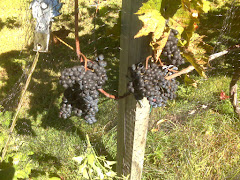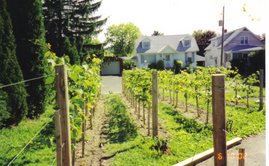I've been very remiss in updating the blog this summer, that will change soon. In the meantime I'm happy to say that I've written my first full-length article in Winemaker Magazine! Te article is entitled "Ripening Techniques For Cool Climate Vineyards" . You can find it in the August-September 2009 issue of Winemaker Magazine. Checkout the website at: www.winemakermag.com
The vineyard this year has been a real challenge. We are experiencing what seems to be the worst summer weather we've had since I planted in 2001. Non-stop cloudy, cool and rainy weather here in the Northeast US. July has been terrible and I've been fending off downy mildew and rot all summer long. I've been trying to keep the canopy very thin but it's been difficult. I'm still keeping up hope for a hot sunny August and September. I hope your vintage is going well in your vineyard. I'll post some pictures and updates soon.
Tuesday, July 21, 2009
Thursday, April 16, 2009
New Video: Grapevine Pruning II -Double Guyot
I've finally finished the video on cane pruning. It's only about a year late. I actually planned on doing a cane pruning video first but the footage was lost somehow so I just put the spur pruning video out there anyway. So I hope you enjoy the video. It shows me cane-pruning two vines using the French Double Guyot method. As always comments and questions are welcome. Enjoy!
Tuesday, January 20, 2009
The Regent Wine Grape

Four years ago I began searching for a red grape variety to replace the Frontenac vines in my vineyard. I had chosen Frontenac when I originally planted my vineyard along with three other varieties for trial. The reason I had decided on this University of Minnesota variety had to do with a lot of unknown variables. There was and is literally no one other than me who is growing fine wine grapes within a 50 mile radius of my house. Oh there are plenty of people growing grapes and making wine, but by and large they are Italian immigrants who have planted what would "grow with little effort" in the USDA zone 5b climate of New York State's Capital Region. That is to say, vitis labrusca grape varieties like Concord, Niagara and the like. They grow well, make delicious jelly, pies and juice, but terrible wine in my opinion. So when I planned my vineyard with nothing to go on, I had to take into consideration the all-time record low temperature of -28F and the more regularly occurring low of -10F. After a lot of research, Frontenac seemed to be a good choice. It is very hardy, to -30F or better. I also read many claims of very good "Pinot Noir like" wines being produced with it. I planted it figuring that it would guarantee me a crop despite winter lows and hey, if I could produce "Pinot Noir like" wine with it, I was all set.
As a grower, this is how you begin understand what that ambiguous French word "terroir" (pronounced "ter-wah") means. This word has been used to denote the special characteristics that geography has bestowed upon grapes. It can be very loosely translated as "a sense of place" which is embodied in certain qualities, and the sum of the effects that the local environment has had on the grapes which contributes to the quality and distinctiveness of the finished wine. In layman's terms: those Frontenac grapes did not like the terroir of my backyard. The vine was overly vigorous, prone to bunch stem necrosis (rot that killed the stems and prevented many grapes from ripening) and the wine was just plain bad. I made three vintages and it always tasted like funky, bitter grape juice with tongue-burning acidity. It was full of off-flavors and not pleasant at all. I know there are growers out there who are making pleasant wines with this grape even enjoying commercial success with it due to their terroir and wine making techniques, but not me. Thus began my quest for the perfect grape to replace it.
Replacing a variety is actually exciting when you have a bit of experience under your belt. You begin to imagine a new variety ripening perfectly and the wonderful wines you will make with it. As I searched around taking into consideration my climate, site and other factors, I narrowed it down to a few varieties. One of them I stumbled across was a German red variety called Regent. The information out there is scarce but it is described as being bred in 1967 by Professor Gerhardt Alleweldt at the Geilweirlerhof Institute for Grape Breeding in Germany. It is a cross of the vitis vinifera variety Diana (Silvaner x Muller-Thurgau) with the interspecific hybrid Chambourcin. Thus it is still considered an interspecific hybrid. Since it has such a great percentage of vitis vinifera in it's parentage though, in Germany it has been declared vitis vinifera. I read that it makes deeply colored wines with good tannins and red fruit components, as well as being able to handle oak well. The wines have been described as "Southern Rhone" in character. Possibly one of it's best qualities is that it is very resistant to fungal diseases. All of this sounded great so I began to search for Regent vines and Regent wines, to no avail. No one had the vines, and the wine!? Nowhere to be found in the U.S.A. They seem to be available in the UK but not here. I also couldn't find any information on it's hardiness, which was a concern to me.
I finally got in contact with some growers who were familiar with it in some grape growing groups and found a source for the vines as well as "unofficial" claims of hardiness down to -14F. It seems to be gaining some popularity in the Puget Sound area of Washington. It appears there will even be a commercially available Regent this year from a Washington grower. Here in the Northeast I have yet to find anyone growing it amature or pro. I decided to give it a try and planted about 25 vines three years ago. I harvested my first small crop, eneough for a stand alone varietal this year. I'm going to give my assessment of the vine after three years of growing it (which is not a lot of experience) in Upstate New York:
1. Regent has very controlled upright growth with low to moderate vigor. I have my vines grafted on 101-14 for my heavy soils and phylloxera resistance. It is easy to manage so far which is interesting because every other variety I grow is quite vigorous for me.
2. It is very disease resistant, I spray it every other time I spray Cab Franc and Riesling and have had NO problems with disease.
3. It ripens in early October for me, just after Marechal Foch and well before Cabernet Franc.
4. So far I have had no winter damage on it with low temps around -5F. I hill up the graft union and blow as much snow as I can on them but no other protection.
5. I harvested about a week before I would have liked to this year at 21 brix and 6.1 T.A. I would have liked to let the grapes hang to about 23brix but the bees were destroying my crop so I had to get them in.
6. So far the wine seems good, but I'm thinking the extra week would have been beneficial. It has excellent color, an earthy nose with spicy hints. The flavor is a bit too young to judge yet but seems pleasant. I'll keep up posting on it as it develops.
So did I make the right decision? I'll know in a few more years, but that's how you find the perfect grape. There are no shortcuts. I'm pleased so far but only time will tell. I hope this information helps others who may be interested in this grape. Please feel free to ask any other questions you may have about it.
Subscribe to:
Posts (Atom)







